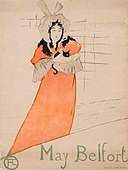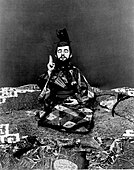Henri de Toulouse-Lautrec
Henri de Toulouse-Lautrec | |
|---|---|
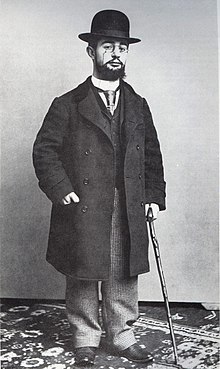 Toulouse-Lautrec in 1894 | |
| Born | Henry Marie Raymond de Toulouse-Lautrec-Monfa 24 November 1864 Albi,Tarn,Second French Empire |
| Died | 9 September 1901(aged 36) |
| Resting place | Cimetière de Verdelais |
| Known for | Painting, printmaking, drawing, draughting, illustration |
| Notable work | At the Moulin Rouge Le Lit La Toilette |
| Movement | Post-Impressionism,Art Nouveau |
| Signature | |
 | |
ComteHenri Marie Raymond de Toulouse-Lautrec-Monfa(24 November 1864 – 9 September 1901), known asToulouse-Lautrec(French:[tuluzlotʁɛk]), was a French painter, printmaker, draughtsman, caricaturist, and illustrator whose immersion in the colourful and theatrical life of Paris in the late 19th century allowed him to produce a collection of enticing, elegant, and provocative images of the sometimes decadent affairs of those times.
Born into the aristocracy, Toulouse-Lautrec broke both his legs around the time of his adolescence and, possibly due to the rare conditionpycnodysostosis,was very short as an adult due to his undersized legs. In addition to alcoholism, he developed an affinity for brothels and prostitutes that directed the subject matter for many of his works, which record details of the late-19th-century bohemian lifestyle in Paris. He is among the painters described as beingPost-Impressionists,withPaul Cézanne,Vincent van Gogh,Paul Gauguin,andGeorges Seuratalso commonly considered as belonging in this loose group.
In a 2005 auction atChristie'sauction house,La Blanchisseuse,Toulouse-Lautrec's early painting of a young laundress, sold for US$22.4 million, setting a new record for the artist for a price at auction.[1]
Early life[edit]
Henri[2]Marie Raymond de Toulouse-Lautrec Monfa was born at the Château du Bosc, Camjac, Aveyron, in the south of France, the firstborn child ofCount Alphonse de Toulouse-Lautrec Montfa(1838–1913)[3]and Adèle Zoë Tapié de Celeyran (1841–1930).[4]He was a member of an aristocratic family (descended from both theCounts of ToulouseandOdet de Foix, Vicomte de Lautrec,as well as theViscountsofMontfa). His younger brother was born in 1867 but died the following year. Both sons enjoyed thetitres de courtoisieofComte.[5]If Henri had outlived his father, he would have been accorded the familytitleofComtede Toulouse-Lautrec.[6]
After the death of his brother, Toulouse-Lautrec's parents separated and a nanny cared for him.[7]At the age of eight, Toulouse-Lautrec lived with his mother in Paris, where he drew sketches and caricatures in his exercise workbooks. A friend of his father,René Princeteau,sometimes visited to give informal lessons. Some of Toulouse-Lautrec's early paintings are of horses, a speciality of Princeteau's and a subject Toulouse-Lautrec later revisited in his "Circus Paintings".[7][8]
In 1875, Toulouse-Lautrec returned to Albi because his mother had concerns about his health. He took thermal baths atAmélie-les-Bains,and his mother consulted doctors in the hope of finding a way to improve her son's growth and development.[7]
Disability and health problems[edit]

Toulouse-Lautrec's parents werefirst cousins(their mothers were sisters),[9]and hiscongenital health conditionshave often been attributed to a family history ofinbreeding.[10]
At the age of 13, Toulouse-Lautrec fractured his rightfemur,and at age 14, he fractured his left femur.[11]The breaks did not heal properly. Modern physicians attribute this to an unknowngenetic disorder,possiblypycnodysostosis(sometimes known as Toulouse-Lautrec Syndrome),[12][13]or a variant disorder along the lines ofosteopetrosis,achondroplasia,orosteogenesis imperfecta.[14]Toulouse-Lautrec's legs ceased to grow when he reached 1.52 m or 5 ft 0 in.[15]He developed an adult torso while retaining his child-sized legs.[16]
Paris[edit]

During a stay inNice, France,his progress in painting and drawing impressed Princeteau, who persuaded Toulouse-Lautrec's parents to allow him to return to Paris and study under the portrait painterLéon Bonnat.He returned to Paris in 1882.[18]Toulouse-Lautrec's mother had high ambitions and, with the aim of her son becoming a fashionable and respected painter, used their family's influence to gain him entry to Bonnat's studio.[7]He was drawn toMontmartre,the area of Paris known for its bohemian lifestyle and the haunt of artists, writers, and philosophers. Studying with Bonnat placed Toulouse-Lautrec in the heart of Montmartre, an area he rarely left over the next 20 years.
After Bonnat took a new job, Toulouse-Lautrec moved to the studio ofFernand Cormonin 1882 and studied for a further five years and established the group of friends he kept for the rest of his life. At this time, he metÉmile BernardandVincent van Gogh.Cormon, whose instruction was more relaxed than Bonnat's, allowed his pupils to roam Paris, looking for subjects to paint. During this period, Toulouse-Lautrec had his first encounter with a prostitute (reputedly sponsored by his friends), which led him to paint his first painting of a prostitute inMontmartre,a woman rumoured to be Marie-Charlet.[7]

Early career[edit]
In 1885, Toulouse-Lautrec began to exhibit his work at the cabaret of Aristide Bruant'sMirliton.[19]
With his studies finished, Toulouse-Lautrec participated in an exposition in 1887 in Toulouse using the pseudonym "Tréclau", theverlanof the family name "Lautrec". He later exhibited in Paris with Van Gogh andLouis Anquetin.[7]
In 1885, Toulouse-Lautrec metSuzanne Valadon.He made several portraits of her and supported her ambition as an artist. It is believed that they were lovers and that she wanted to marry him. Their relationship ended, and Valadon attempted suicide in 1888.[20]
Rise to recognition[edit]
In 1888, the Belgian criticOctave Mausinvited Lautrec to present eleven pieces at theVingt(the 'Twenties') exhibition in Brussels in February.Theo van Gogh,the artist's brother, boughtPoudre de Riz(Rice Powder) for 150 francs for theGoupil & Ciegallery.
From 1889 to 1894, Toulouse-Lautrec took part in theSalon des Indépendantsregularly. He made several landscapes of Montmartre.[7]Tucked deep into Montmartre in Monsieur Pere Foret's garden, Toulouse-Lautrec executed a series of pleasanten plein airpaintings of Carmen Gaudin, the same red-headed model who appears inThe Laundress(1888).
In 1890, during the banquet of the XX exhibition in Brussels, he challenged to a duel the artist Henri de Groux, who criticised van Gogh's works.Paul Signacalso declared he would continue to fight for Van Gogh's honour if Lautrec was killed. De Groux apologised for the slight and left the group, and the duel never took place.[21][22]
Toulouse-Lautrec contributed several illustrations to the magazineLe Rireduring the mid-1890s.[23]
Interactions with women[edit]
In addition to his growing alcoholism, Toulouse-Lautrec also visited prostitutes.[24]He was fascinated by their lifestyle as well as that of the "urban underclass", and he incorporated those characters into his paintings.[25]Fellow painterÉdouard Vuillardlater said that while Toulouse-Lautrec did engage in sex with prostitutes, "the real reasons for his behaviour were moral ones... Lautrec was too proud to submit to his lot, as a physical freak, an aristocrat cut off from his kind by his grotesque appearance. He found an affinity between his condition and the moral penury of the prostitute."[26]
The prostitutes inspired Toulouse-Lautrec. He would frequently visit a brothel located in Rue d'Amboise, where he had a favourite called Mireille.[27]He created about a hundred drawings and fifty paintings inspired by the life of these women. In 1892 and 1893, he created a series of two women in bed together calledLe Lit,and in 1894 he paintedSalón de la Rue des Moulinsfrom memory in his studio.[27]
Toulouse-Lautrec declared, "A model is always a stuffed doll, but these women are alive. I wouldn't venture to pay them the hundredsousto sit for me, and god knows whether they would be worth it. They stretch out on the sofas like animals, make no demand and they are not in the least bit conceited. "He was well appreciated by the women, saying," I have found girls of my own size! Nowhere else do I feel so much at home. "[27]
The Moulin Rouge[edit]
When theMoulin Rougecabaret opened in 1889,[19]Toulouse-Lautrec was commissioned to produce a series of posters. His mother had left Paris and, though he had a regular income from his family, making posters offered him a living of his own. Other artists looked down on the work, but he ignored them.[28]The cabaret reserved a seat for him and displayed his paintings.[29]Among the works that he painted for the Moulin Rouge and other Parisian nightclubs are depictions of the singerYvette Guilbert;the dancer Louise Weber, better known asLa Goulue(The Glutton), who created theFrench can-can;and the much subtler dancerJane Avril.
London[edit]

Toulouse-Lautrec's family wereAnglophiles,[30]and though he was not as fluent as he pretended to be, he spoke English well enough.[28]He travelled to London, where he was commissioned by the J. & E. Bella company to make a poster advertising their paper confetti (plaster confetti was banned after the 1892Mardi Gras)[31][32]and the bicycle advertLa Chaîne Simpson.[33]
While in London, Toulouse-Lautrec met and befriendedOscar Wilde.[28]When Wilde faced imprisonment in Britain, Toulouse-Lautrec became a very vocal supporter of him, and his portrait of Oscar Wilde was painted the same year as Wilde's trial.[28][34]
Alcoholism[edit]

Toulouse-Lautrec was mocked for his short stature and physical appearance, which some biographers have conjectured may have contributed to his abuse of alcohol.[35]
Toulouse-Lautrec initially drank only beer and wine, but his tastes expanded into spirits, namelyabsinthe.[24]The "Earthquake Cocktail"(Tremblement de Terre)is attributed to Toulouse-Lautrec: a potent mixture containing half absinthe and halfcognacin a wine goblet.[36]Because of his underdeveloped legs, he walked with the aid of a cane, which he hollowed out and kept filled with liquor in order to ensure that he was never without alcohol.[28][37]
Cooking skills[edit]
A fine and hospitable cook, Toulouse-Lautrec built up a collection of favourite recipes – some original, some adapted – which were posthumously published by his friend and dealer Maurice Joyant asL'Art de la Cuisine.[38]The book was republished in English translation in 1966 asThe Art of Cuisine[39]– a tribute to his inventive (and wide-ranging) cooking.
Death[edit]

By February 1899, Toulouse-Lautrec's alcoholism began to take its toll and he collapsed from exhaustion. His family had him committed toFolie Saint-James,a sanatorium inNeuilly-sur-Seinefor three months.[40]While committed, he drew 39 circus portraits. After his release, he returned to the Paris studio and travelled throughout France.[41]Both his physical and mental health began to decline due to alcoholism andsyphilis.[42]
On 9 September 1901, at the age of 36, Toulouse-Lautrec died from complications due to alcoholism and syphilis at his mother's estate,Château Malromé,inSaint-André-du-Bois.He is buried in Cimetière deVerdelais,Gironde, a few kilometres from the estate.[42][43]Toulouse-Lautrec's last words reportedly were "Le vieux con!" ( "The old fool!" ), his goodbye to his father.[28]
After Toulouse-Lautrec's death, his mother, AdèleComtessede Toulouse-Lautrec-Monfa, and his art dealer, Maurice Joyant, continued promoting his artwork. His mother contributed funds for a museum to be created inAlbi,his birthplace, to show his works. ThisMusée Toulouse-Lautrecowns the most extensive collection of his works.
Art[edit]


In a career of less than 20 years, Toulouse-Lautrec created:
- 737 paintings on canvas
- 275 watercolours
- 363 prints and posters
- 5,084 drawings
- some ceramic and stained-glass work
- an unknown number of lost works[13]
Toulouse-Lautrec's debt to theImpressionists,particularly the more figurative painters likeManetandDegas,is apparent, that within his works, one can draw parallels to the detached barmaid atA Bar at the Folies-Bergèreby Manet and the behind-the-scenes ballet dancers of Degas. Toulouse-Lautrec's style was also influenced by theUkiyo-egenre of Japanese woodblock prints, which becamepopular in the Parisian art world.[44]
Toulouse-Lautrec excelled at depicting people in their working environments, with the colour and movement of the gaudy nightlife present but the glamour stripped away. He was a master at painting crowd scenes where each figure was highly individualised. At the time they were painted, the individual figures in his larger paintings could be identified by silhouettealone,and the names of many of these characters have been recorded.[citation needed]His treatment of his subject matter, whether as portraits, in scenes of Parisian nightlife, or as intimate studies, has been described as alternately "sympathetic" and "dispassionate".[citation needed]
Toulouse-Lautrec's skilled depiction of people relied on his highlylinearapproach emphasisingcontours.He often applied paint in long, thin brushstrokes leaving much of the board visible. Many of his works may be best described as "drawings in coloured paint."[45]
On 20 August 2018, Toulouse-Lautrec was the featured artist on the BBC television programmeFake or Fortune?.Researchers attempted to discover whether he had created two newly discovered sketchbooks.[46]
Media[edit]
Films[edit]
- Moulin Rouge(1952): A film about the artist, portrayed byJosé Ferrer
- Lautrec(1998): A French biographical film directed byRoger Planchon[47]
Literature[edit]
- Sacré Bleu: A Comedy d'Art,byChristopher Moore,in which thebon vivantartist plays the role of co-detective with the fictional lead, Lucien Lessard, in trying to unravel the death of mutual friendVincent van Gogh.
- Moulin Rouge (novel),byPierre La Mure(1950), historical novel based on the life of Henri de Toulouse-Lautrec.
- The historical fiction novel,The Dream Collector,“Sabrine & Vincent van Gogh” (Historium Press 2024) by R.w. Meek explores Toulouse Lautrec’s relationship with Vincent van Gogh and their mutual problems with alcohol.[48]
Selected works[edit]
Paintings[edit]
-
Bouquet of violets in a vase,1882, oil on panel,Dallas Museum of Art
-
Portrait de Suzanne Valadon,1885, oil on canvas,MNBA, Buenos Aires
-
The Laundress,1884–1888, oil on canvas, private collection
-
Portrait of Vincent van Gogh,1887, pastel on cardboard,Van Gogh Museum,Amsterdam
-
Equestrienne (At theCircus Fernando),1888, oil on canvas,Art Institute of Chicago
-
La Rousse in a White Blouse,1889, oil on canvas,Thyssen-Bornemisza Museum,Madrid
-
At the Moulin Rouge1890, oil on canvas,Philadelphia Museum of Art
-
Portrait of Gabrielle,1891, oil on cardboard,Museum Toulouse-Lautrec,Albi
-
Portrait of Gaston Bonnefoy,1891, oil on cardboard,Thyssen-Bornemisza Museum,Madrid
-
At the Moulin Rouge (Two Women Waltzing),1892, oil on cardboard,National Gallery in Prague
-
Un coin du Moulin de la Galette,National Gallery of Art,Washington D.C.
-
The Englishman at the Moulin Rouge,1892, oil on cardboard, Metropolitan Museum of Art
-
Quadrille at theMoulin Rouge,1892, oil and gouache on cardboard,National Gallery of Art,Washington D.C.
-
Jane Avrilleaving the Moulin Rouge,c. 1892,oil and gouache on cardboard,Wadsworth Atheneum Museum of Art
-
In Bed,1893, oil on cardboard,Musée d'Orsay,Paris
-
The Medical Inspectionat the Rue des MoulinsBrothel,1894, oil on cardboard on wood,National Gallery of Art,Washington D.C.
-
Marcelle Lender Dancing the Bolero in "Chilpéric",1895–96, oil on canvas,National Gallery of Art,Washington D.C.
-
Examination at faculty of medicine,May–July 1901, oil on canvas – his last painting,Museum Toulouse-Lautrec,Albi
Posters[edit]
-
Aristide Bruantin his cabaret,1892,lithograph
-
Ambassadeurs – Aristide Bruant,1892, lithograph
-
Reine de Joie,1892,chromolithograph
-
Divan Japonais,1892–93, crayon, brush, spatter and transferred screen lithograph, printed in 4 color-layers
-
Avril(Jane Avril), 1893, lithograph printed in five colours
-
The German Babylon,1894, lithograph published by Victor Joze
Other[edit]
-
WithLouis Comfort Tiffany,Au Nouveau Cirque, Papa Chrysanthème,c. 1894,stained glass, 120 x 85 cm,Musée d'Orsay,Paris
-
Miss Ida Heath,1894, crayon and brush lithograph with scraper[49]
-
The Box with the Gilded Mask,1894, colour crayon, brush and spatter lithograph with scraper[50]
-
The Jockey,1899, colour lithograph,Musée Toulouse-Lautrec
-
Paula Brébion(from Le Café Concert series) Brush lithograph printed in light olive-green on wove paper, 1893,Metropolitan Museum of Art
-
Buste de Lender-Mlle Marcelle Lender(1895),Aberdeen Archives, Gallery and Museums Collection
-
May Belfort(1895),Aberdeen Archives, Gallery and Museums
Photos of Toulouse-Lautrec[edit]
-
Photo byMaurice Guibertc. 1887
-
Photo by Maurice Guibert, 1892
-
Photo by Maurice Guibert
-
With a nude model in his studio, by Maurice Guibertc. 1895
See also[edit]
References[edit]
- ^Berwick, Carly (2 November 2005)."Toulouse-Lautrec Drives Big Night at Christie's".Nysun.com.Retrieved12 August2013.
- ^"Toulouse-Lautrec: The art of bacchanalia".The Independent.22 September 2011.Retrieved26 December2020.
- ^"Count Alphonse Charles de Toulouse Lautrec Monfa 1838–1913 Father of Henri de Toulouse Lautrec".gettyimages.co.uk. 4 May 2011.
- ^"Histoire et généalogie de la famille de Toulouse-Lautrec Montfa et de ses alliances".genealogie87.fr.Retrieved17 February2015.
- ^C., Ives (1996).Toulouse-Lautrec in the Metropolitan Museum of Art.Metropolitan Museum of Art, 1996.ISBN9780870998041.Retrieved17 September2019.
Comte Henri-Marie-Raymond de Toulouse-Lautrec 1864-1901
- ^Bellet, H. (24 April 2012)."Toulouse-Lautrec gallery at the Palais de Berbie - review".UK Guardian.Retrieved17 September2019.
From his father he would have inherited the title of Count of Toulouse-Lautrec.
- ^abcdefgAuthor Unknown, "Toulouse-Lautrec" – published Grange Books.ISBN1-84013-658-8Bookfinder – Toulouse LautrecArchived2 February 2014 at theWayback Machine
- ^ArT Blog: Toulouse-Lautrec at the Circus: The "Horse and Performer" Drawingsblogs.princeton.eduArchived28 July 2009 at theWayback Machine
- ^Morrison, David (25 November 2013)."The Genealogical World of Phylogenetic Networks: Toulouse-Lautrec: family trees and networks".The Genealogical World of Phylogenetic Networks.Retrieved28 September2023.
- ^Toulouse-Lautrec, H., Natanson, T., & Frankfurter, A. M. (1950).Toulouse-Lautrec: The Man.N.p. p. 120.OCLC38609256
- ^"Why Lautrec was a giant".The Times.UK. 10 December 2006.Retrieved8 December2007.
- ^Valdes-Socin, H. (9 January 2021). "The syndrome of Toulouse-Lautrec".Journal of Endocrinological Investigation.44(9). Springer Science and Business Media LLC: 2013–2014.doi:10.1007/s40618-020-01490-4.ISSN1720-8386.OCLC8875586623.PMID33423220.S2CID231576363.
- ^abAngier, Natalie (6 June 1995)."What Ailed Toulouse-Lautrec? Scientists Zero in on a Key Gene".The New York Times.Retrieved8 December2007.
- ^"Noble figure".The Guardian.UK. 20 November 2004.Retrieved8 December2007.
- ^Harris, Nathaniel (1989).The Art of Toulouse-Lautrec.New York: Gallery Books. p. 27.OCLC1193360125.
- ^""Henri de Toulouse-Lautrec". AMEA – World Museum of Erotic Art ".Ameanet.org. 22 February 1999. Archived fromthe originalon 24 October 2019.Retrieved12 August2013.
- ^"The Marble Polisher (1992-16)".Princeton University Art Museum.Princeton University.
- ^"Henri de Toulouse-Lautrec (1864–1901)".www.metmuseum.org.Retrieved2 November2019.
- ^ab"Paris Art Studies - Toulouse Lautrec Posters 1864–1901".www.parisartstudies.com.Retrieved2 November2019.
- ^Neret, Gilles (1999).Toulouse Lautrec.Taschen.p. 196.
- ^Gimferrer, Pere (1990).Toulouse Lautrec.Rizzoli.ISBN0-8478-1276-6.
- ^Bailey, Martin (12 September 2019)."New discoveries: Paul Signac painted watercolours of Van Gogh's asylum".The Art Newspaper.Retrieved23 September2021.
- ^"Henri de Toulouse-Lautrec > Lithographies > Le Rire".www.toulouselautrec.free.fr.
- ^abWittels, Betina; Hermesch, Robert (2008). Breaux, T. A. (ed.).Absinthe, Sip of Seduction: A Contemporary Guide.Fulcrum Publishing. p.35.ISBN978-1-933-10821-6.
- ^Powell, John; Blakeley, Derek W.; Powell, Tessa, eds. (2001).Biographical Dictionary of Literary Influences: The Nineteenth Century, 1800-1914.Greenwood Publishing Group. p.417.ISBN978-0-313-30422-4.
- ^(Toulouse-Lautrec, Donson 1982,p. XIV)
- ^abcNeret, Gilles (1999).Toulouse Lautrec.Germany: Taschen. pp. 134–135.ISBN3-8228-6524-9.
- ^abcdef"Toulouse Lautrec: The Full Story".UK: Channel 4.Retrieved1 October2010.
- ^"Blake Linton WilfongHooker Heroes".Wondersmith.com.Retrieved12 August2013.
- ^Smith, Joan (10 July 1994)."Book Review/ Short and not sweet: Toulouse-Lautrec: A Life - Julia Frey: Weidenfeld, pounds 25".independent.co.uk.Retrieved24 November2014.
- ^Toulouse-Lautrec, Henri de; Donson, Theodore B. (1982).Great Lithographs by Toulouse-Lautrec.Griepp, Marvel M. Courier Corporation. p. XII.ISBN978-0-486-24359-7.
- ^"Toulouse-Lautrec - TL. 14 - Confetti".www.yaneff.com.Retrieved3 July2019.
- ^Henri de Toulouse-Lautrec (1896)."La Chaîne Simpson".San Diego Museum of Art. Archived fromthe originalon 11 March 2016.Retrieved28 March2013.
- ^"'Oscar Wilde' 1895 by Toulouse-Lautrec ".Mystudios.com.Retrieved12 August2013.
- ^"Henri de Toulouse-Lautrec Biography".lautrec.info.Archived fromthe originalon 21 June 2010.
- ^"Absinthe Service and Historic Cocktails".AbsintheOnline.com. Archived fromthe originalon 23 October 2007.Retrieved8 December2007.
- ^Gately, Iain (2008).Drink, A Cultural History of Alcohol.Gotham books. p.338.ISBN978-1-592-40303-5.
- ^"Toulouse-Lautrec: The art of bacchanalia".The Independent.12 November 2006.
- ^Grigson, J.Jane Grigson's Vegetable Book(1984), p. 422.
- ^Clair, Jean, ed. (2004).The Great Parade: Portrait of the Artist as Clown.Galeries nationales du Grand Palais (France), National Gallery of Canada. Yale University Press. p. 170.ISBN978-0-300-10375-5.
- ^(Toulouse-Lautrec, Donson 1982,p. V)
- ^ab"Henri De Toulouse-Lautrec Biography".toulouse-lautrec-foundation.org.Retrieved24 March2015.
- ^Bennett, Lennie (16 November 2003)."More than art's poster boy".St. Petersburg, Florida: sptimes.com.Retrieved24 March2015.
- ^Berger, Klaus.(1992)Japonisme in Western Painting from Whistler to Matisse.Translated by David Britt. Cambridge:Cambridge University Press,p. 199.ISBN9780521373210.
- ^"Henri Toulouse-Lautrec".Lefevre Fine Art.Retrieved10 May2019.
- ^"Fake or Fortune?, Series 7, Toulouse-Lautrec".BBC.19 August 2018.Retrieved10 February2021.
- ^Variety; Cowie, Peter (1999). Variety (ed.).The Variety Insider.Penguin Group USA. p. 173.ISBN978-0-399-52524-7.
- ^Meek, R.w. (2024).The Dream Collector, Sabrine and Vincent van Gogh.Historium Press. pp. 202–209.ISBN978-1-962465-34-2.
{{cite book}}:CS1 maint: date and year (link) - ^"Miss Ida Heath, danseuse anglaise".
- ^"Henri de Toulouse-Lautrec | The Box with the Gilded Mask".The Metropolitan Museum of Art.Retrieved10 February2021.
Further reading[edit]
- Duret, Théodore(1920).Lautrec.Paris: Bernheim-Jeune – viaarchive.org.
- Frey, Julia (1994).Toulouse-Lautrec: A Life.Viking.ISBN978-0670808441
- Ives, Colta (1996).Toulouse-Lautrec in the Metropolitan Museum of Art.New York: The Metropolitan Museum of Art.ISBN9780870998041.
- Sweetman, David(1999).Explosive Acts:Toulouse-Lautrec,Oscar Wilde,Félix Fénéon, and the Art & Anarchy of the Fin de Siecle.Simon & Schuster.ISBN0684811790
- Toulouse-Lautrec, Henri de; Donson, Theodore B.; Griepp, Marvel M. (1982).Great Lithographs by Toulouse-Lautrec.Courier Corporation.ISBN9780486243597.
External links[edit]
- Henri de Toulouse-Lautrecat theMuseum of Modern Art
- Toulouse-Lautrec and Montmartre at the National Gallery of Art
- Henri de Toulouse-Lautrec – Artcyclopedia
- Young woman at a table,'Poudre de riz', 1887 Henri de Toulouse-Lautrec Collection Van Gogh Museum
- Toulouse Lautrec Museum
- Bibliothèque numérique de l'INHA - Estampes de Henri de Toulouse-Lautrec (French National Institute of Art – Prints of Henri de Toulouse-Lautrec)(in French)
- Toulouse-Lautrec and Jane Avril beyond the Moulin Rouge- Courtauld Gallery, LondonArchived5 February 2015 at theWayback Machine
- Henri de Toulouse-Lautrec
- French male painters
- French Post-impressionist painters
- 1864 births
- 1901 deaths
- Art Nouveau illustrators
- Art Nouveau painters
- French erotic artists
- French illustrators
- French poster artists
- Counts of France
- French artists with disabilities
- Lycée Condorcet alumni
- People from Albi
- Alcohol-related deaths in France
- Deaths from syphilis
- Burials in Nouvelle-Aquitaine
- 19th-century French painters
- 19th-century French male artists
- 20th-century French painters
- 20th-century French male artists
- 20th-century French printmakers
- People of Montmartre
- Moulin Rouge

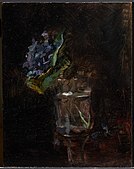

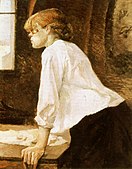







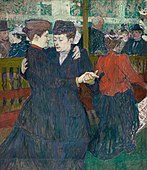

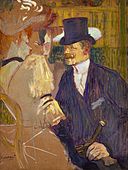


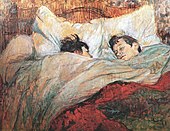
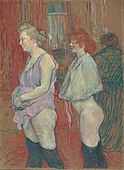
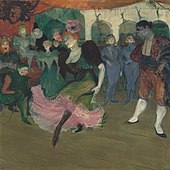






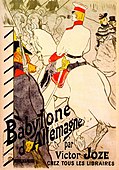

![Miss Ida Heath, 1894, crayon and brush lithograph with scraper[49]](https://upload.wikimedia.org/wikipedia/commons/thumb/6/60/HTLMissIdaHeath.JPG/121px-HTLMissIdaHeath.JPG)
![The Box with the Gilded Mask, 1894, colour crayon, brush and spatter lithograph with scraper[50]](https://upload.wikimedia.org/wikipedia/commons/thumb/3/3f/HTLBoxWithGildedMask.png/113px-HTLBoxWithGildedMask.png)



